

Compact Muon Solenoid
LHC, CERN
| CMS-PAS-HIN-19-007 | ||
| Fragmentation of jets containing a J/ψ meson in PbPb and pp collisions at 5 TeV | ||
| CMS Collaboration | ||
| June 2020 | ||
| Abstract: Jets containing a J/ψ meson are studied in PbPb collisions at a center of mass energy of √sNN= 5.02 TeV, using the CMS detector at the LHC. Jets are selected to be in the transverse momentum range of 30 <pT< 40 GeV. The yield of J/ψ in these jets is evaluated as function of the jet fragmentation function variable z, the ratio of the J/ψ pT to the jet pT. The nuclear modification factor is then derived by comparing the yield in PbPb to the corresponding expectation from pp data at the same collision energy. The suppression of the J/ψ yield shows a dependence on z, indicating that the interaction of the J/ψ with the quark-gluon plasma formed in heavy-ion collisions depends on the fragmentation pattern of the jet that gives rise to the J/ψ meson. | ||
|
Links:
CDS record (PDF) ;
CADI line (restricted) ;
These preliminary results are superseded in this paper, Submitted to PLB. The superseded preliminary plots can be found here. |
||
| Figures | |
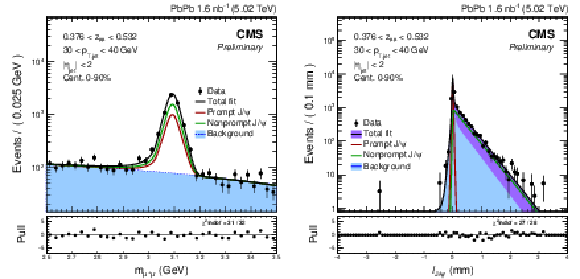
png pdf |
Figure 1:
Projections of a two-dimensional fit used to extract the prompt J/ψ yield in PbPb collisions. Left: The invariant mass distribution. Right: The lJ/ψ distribution. |

png pdf |
Figure 1-a:
Projections of a two-dimensional fit used to extract the prompt J/ψ yield in PbPb collisions. Left: The invariant mass distribution. Right: The lJ/ψ distribution. |

png pdf |
Figure 1-b:
Projections of a two-dimensional fit used to extract the prompt J/ψ yield in PbPb collisions. Left: The invariant mass distribution. Right: The lJ/ψ distribution. |
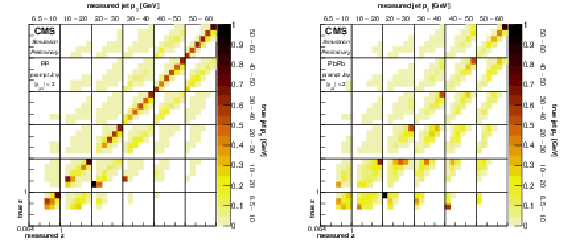
png pdf |
Figure 2:
Detector response matrices for jets containing a prompt J/ψ meson, showing the bin migration probability as a function of jet pT and z. The response for pp collisions (left) is evaluated using PYTHIA 8. The response for PbPb collisions (right) is evaluated using PYTHIA 8 embedded into HYDJET. |

png pdf |
Figure 2-a:
Detector response matrices for jets containing a prompt J/ψ meson, showing the bin migration probability as a function of jet pT and z. The response for pp collisions (left) is evaluated using PYTHIA 8. The response for PbPb collisions (right) is evaluated using PYTHIA 8 embedded into HYDJET. |
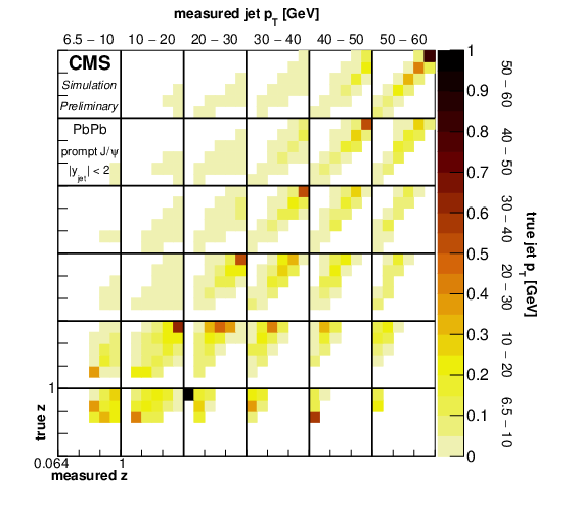
png pdf |
Figure 2-b:
Detector response matrices for jets containing a prompt J/ψ meson, showing the bin migration probability as a function of jet pT and z. The response for pp collisions (left) is evaluated using PYTHIA 8. The response for PbPb collisions (right) is evaluated using PYTHIA 8 embedded into HYDJET. |
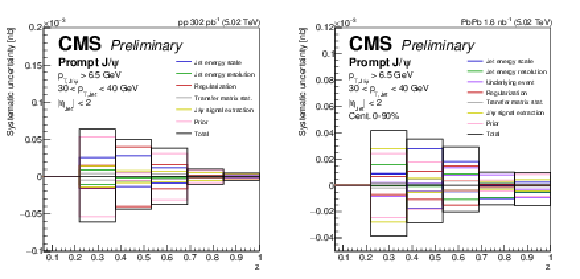
png pdf |
Figure 3:
The main sources of systematic uncertainty, plotted as a function of z in pp (left) and PbPb (right) collisions. |
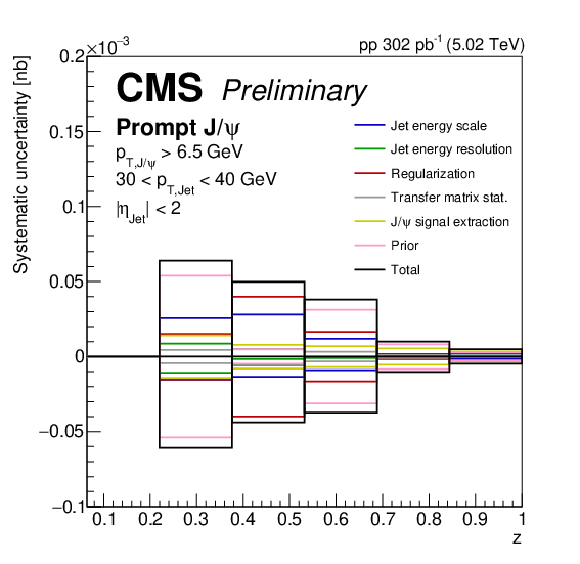
png pdf |
Figure 3-a:
The main sources of systematic uncertainty, plotted as a function of z in pp (left) and PbPb (right) collisions. |
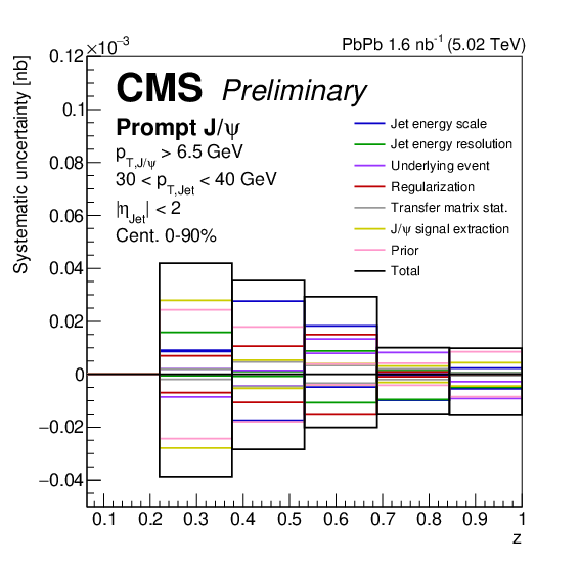
png pdf |
Figure 3-b:
The main sources of systematic uncertainty, plotted as a function of z in pp (left) and PbPb (right) collisions. |
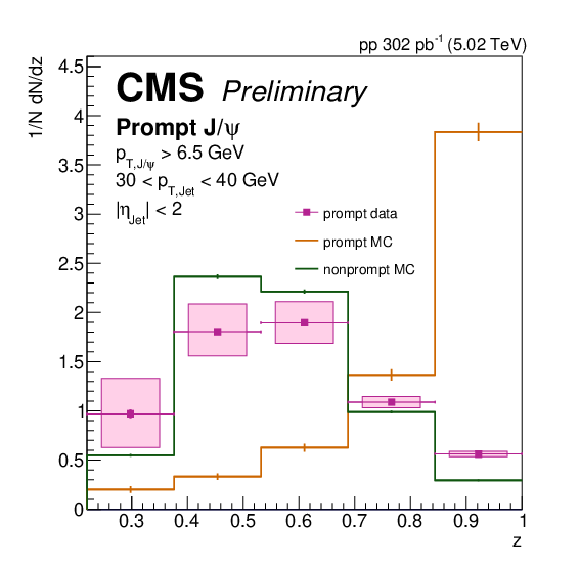
png pdf |
Figure 4:
Normalized z distribution in pp collisions, compared to prompt and nonprompt PYTHIA 8 simulation, at generator level. The shaded boxes represent systematic uncertainties. |
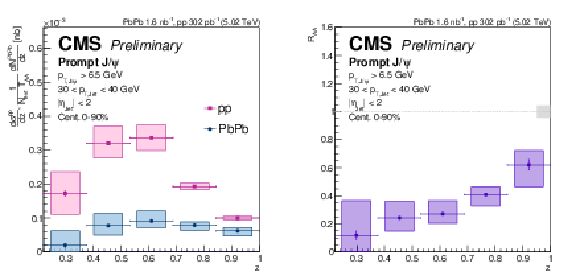
png pdf |
Figure 5:
Left: J/ψ yields as a function of z in pp and PbPb collisions. Right: The nuclear modification factor RAA as a function of z. Bars indicate statistical uncertainties, while systematic uncertainties are depicted as boxes. The box around unity shows the normalization uncertainties. |
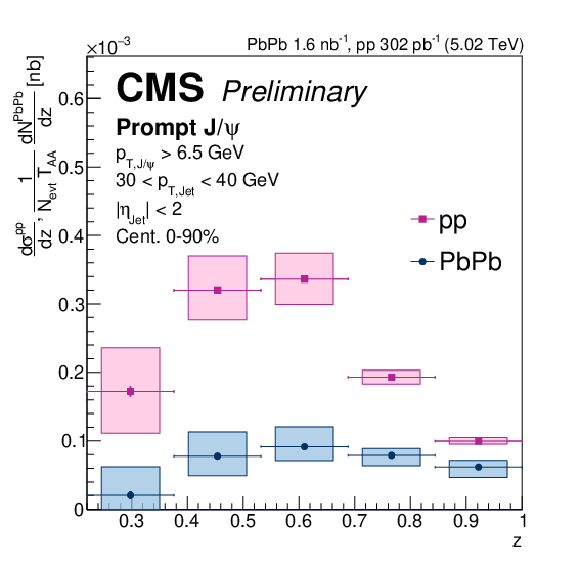
png pdf |
Figure 5-a:
Left: J/ψ yields as a function of z in pp and PbPb collisions. Right: The nuclear modification factor RAA as a function of z. Bars indicate statistical uncertainties, while systematic uncertainties are depicted as boxes. The box around unity shows the normalization uncertainties. |
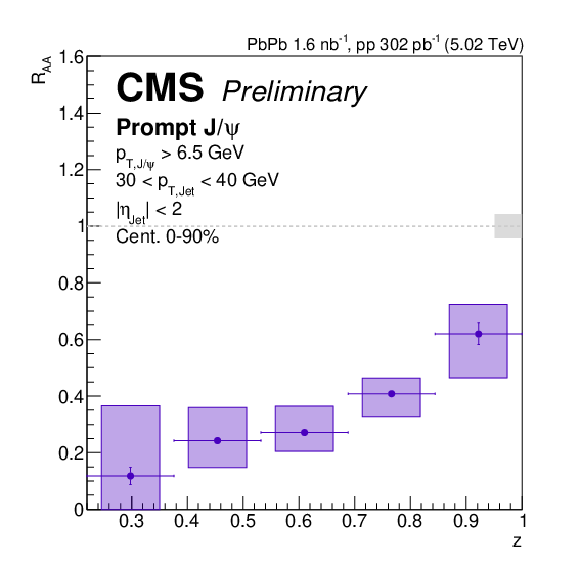
png pdf |
Figure 5-b:
Left: J/ψ yields as a function of z in pp and PbPb collisions. Right: The nuclear modification factor RAA as a function of z. Bars indicate statistical uncertainties, while systematic uncertainties are depicted as boxes. The box around unity shows the normalization uncertainties. |

png pdf |
Figure 6:
The nuclear modification factor RAA for two centrality selections of PbPb collisions as a function of z. Due to limited statistical precision, the lowest z bin is excluded. Bars indicate statistical uncertainties, while systematic uncertainties are depicted as boxes. The boxes around unity show the normalization uncertainties. |
| Summary |
| Jets containing a J/ψ meson were studied in pp and PbPb collisions at √sNN= 5.02 TeV, for jets of 30 <pT< 40 GeV and |η|< 2. We compared the distribution of the fragmentation variable z, the ratio of the J/ψ pT to that of the jet, between the two systems. The resulting nuclear modification factor shows a rising trend as a function of z. The suppression at low z is found to be larger in the 20% most central events, compared to the rest. The results show explicitly that the J/ψ produced with a large degree of surrounding jet activity are more highly suppressed than those produced in isolation. |
| References | ||||
| 1 | T. Matsui and H. Satz | J/ψ suppression by quark-gluon plasma formation | PLB 178 (1986) 416 | |
| 2 | P. Braun-Munzinger and J. Stachel | (Non) thermal aspects of charmonium production and a new look at J/ψ suppression | PLB 490 (2000) 196 | nucl-th/0007059 |
| 3 | PHENIX Collaboration | J/ψ production versus centrality, transverse momentum, and rapidity in AuAu collisions at √sNN= 200 GeV | PRL 98 (2007) 232301 | nucl-ex/0611020 |
| 4 | PHENIX Collaboration | J/ψ suppression at forward rapidity in AuAu collisions at √sNN= 200 GeV | PRC 84 (2011) 054912 | 1103.6269 |
| 5 | ALICE Collaboration | J/ψ suppression at forward rapidity in PbPb collisions at √sNN= 2.76 TeV | PRL 109 (2012) 072301 | 1202.1383 |
| 6 | NA50 Collaboration | Evidence for deconfinement of quarks and gluons from the J/ψ suppression pattern measured in Pb + Pb collisions at the CERN SPS | PLB 477 (2000) 28--36 | |
| 7 | LHCb Collaboration | Study of J/ψ Production in Jets | PRL 118 (2017) 192001 | 1701.05116 |
| 8 | R. Bain et al. | NRQCD Confronts LHCb Data on Quarkonium Production within Jets | PRL 119 (2017) 032002 | 1702.05525 |
| 9 | F. Arleo | Quenching of hadron spectra in heavy ion collisions at the LHC | PRL 119 (2017) 062302 | 1703.10852 |
| 10 | CMS Collaboration | Measurement of prompt and nonprompt charmonium suppression in PbPb collisions at 5.02 TeV | EPJC 78 (2018) 509 | CMS-HIN-16-025 1712.08959 |
| 11 | ATLAS Collaboration | Prompt and non-prompt J/ψ and ψ(2S) suppression at high transverse momentum in 5.02 TeV Pb+Pb collisions with the ATLAS experiment | EPJC 78 (2018) 762 | 1805.04077 |
| 12 | CMS Collaboration | Charged-particle nuclear modification factors in PbPb and pPb collisions at √sNN= 5.02 TeV | JHEP 04 (2017) 039 | CMS-HIN-15-015 1611.01664 |
| 13 | CMS Collaboration | Suppression and azimuthal anisotropy of prompt and nonprompt J/ψ production in PbPb collisions at √sNN= 2.76 TeV | EPJC 77 (2017) 252 | CMS-HIN-14-005 1610.00613 |
| 14 | M. L. Miller, K. Reygers, S. J. Sanders, and P. Steinberg | Glauber modeling in high-energy nuclear collisions | Ann. Rev. Nucl. Part. Sci. 57 (2007) 205 | nucl-ex/0701025 |
| 15 | CMS Collaboration | Particle-flow reconstruction and global event description with the cms detector | JINST 12 (2017) P10003 | CMS-PRF-14-001 1706.04965 |
| 16 | CMS Collaboration | Performance of the CMS muon detector and muon reconstruction with proton-proton collisions at √s= 13 TeV | JINST 13 (2018) P06015 | CMS-MUO-16-001 1804.04528 |
| 17 | CMS Collaboration | The CMS experiment at the CERN LHC | JINST 3 (2008) S08004 | CMS-00-001 |
| 18 | CMS Collaboration | The CMS trigger system | JINST 12 (2017) P01020 | CMS-TRG-12-001 1609.02366 |
| 19 | T. Sjostrand et al. | An Introduction to PYTHIA 8.2 | CPC 191 (2015) 159 | 1410.3012 |
| 20 | CMS Collaboration | Extraction and validation of a new set of CMS PYTHIA8 tunes from underlying-event measurements | EPJC 80 (2020) 4 | CMS-GEN-17-001 1903.12179 |
| 21 | P. Nason et al. | Bottom production | in Workshop on Standard Model Physics (and more) at the LHC (First Plenary Meeting) | hep-ph/0003142 |
| 22 | I. P. Lokhtin and A. M. Snigirev | A model of jet quenching in ultrarelativistic heavy ion collisions and high-pT hadron spectra at RHIC | EPJC 45 (2006) 211 | hep-ph/0506189 |
| 23 | GEANT Collaboration | GEANT4 --- A simulation toolkit | NIMA 506 (2003) 250 | |
| 24 | Particle Data Group Collaboration | Review of Particle Physics | PRD 98 (2018) 030001 | |
| 25 | M. Pivk and F. R. Le Diberder | sPlot A statistical tool to unfold data distributions | NIMA555 (2005) 356 | physics/0402083 |
| 26 | M. Cacciari, G. P. Salam, and G. Soyez | The anti-kt jet clustering algorithm | JHEP 04 (2008) 063 | 0802.1189 |
| 27 | M. Cacciari, G. P. Salam, and G. Soyez | FastJet user manual | EPJC 72 (2012) 1896 | 1111.6097 |
| 28 | CMS Collaboration | Jet energy scale and resolution in the CMS experiment in pp collisions at 8 TeV | JINST 12 (2017) P02014 | CMS-JME-13-004 1607.03663 |
| 29 | P. Berta, M. Spousta, D. W. Miller, and R. Leitner | Particle-level pileup subtraction for jets and jet shapes | JHEP 06 (2014) 092 | 1403.3108 |
| 30 | G. D'Agostini | A Multidimensional unfolding method based on Bayes' theorem | Nucl.\ Instrum.\ Meth.\ A 362 (1995) 487 | |
| 31 | T. Adye | Unfolding algorithms and tests using RooUnfold | Presented at PHYSTAT 2011, CERN, Geneva, Switzerland, January 2011 | |
| 32 | CMS Collaboration | Performance of CMS muon reconstruction in pp collision events at √s= 7 TeV | JINST 7 (2012) P10002 | CMS-MUO-10-004 1206.4071 |
| 33 | C. Loizides, J. Kamin, and D. d'Enterria | Improved Monte Carlo Glauber predictions at present and future nuclear colliders | PRC 97 (2018) 054910 | 1710.07098 |
| 34 | P. Caucal, E. Iancu, A. Mueller, and G. Soyez | Vacuum-like jet fragmentation in a dense QCD medium | PRL 120 (2018) 232001 | 1801.09703 |

|
Compact Muon Solenoid LHC, CERN |

|

|

|

|

|

|